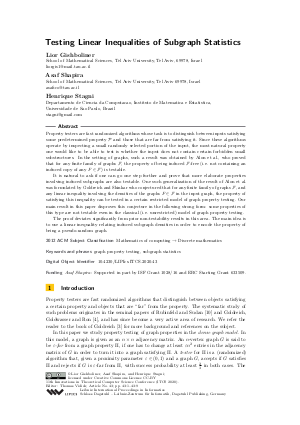Testing Linear Inequalities of Subgraph Statistics
Authors Lior Gishboliner, Asaf Shapira, Henrique Stagni
-
Part of:
Volume:
11th Innovations in Theoretical Computer Science Conference (ITCS 2020)
Part of: Series: Leibniz International Proceedings in Informatics (LIPIcs)
Part of: Conference: Innovations in Theoretical Computer Science Conference (ITCS) - License:
 Creative Commons Attribution 3.0 Unported license
Creative Commons Attribution 3.0 Unported license
- Publication Date: 2020-01-06
File

PDF
LIPIcs.ITCS.2020.43.pdf
- Filesize: 431 kB
- 9 pages
Document Identifiers
Subject Classification
ACM Subject Classification
- Mathematics of computing → Discrete mathematics
Keywords
- graph property testing
- subgraph statistics
Metrics
- Access Statistics
-
Total Accesses (updated on a weekly basis)
0Document
0Metadata
Abstract
Property testers are fast randomized algorithms whose task is to distinguish between inputs satisfying some predetermined property ? and those that are far from satisfying it. Since these algorithms operate by inspecting a small randomly selected portion of the input, the most natural property one would like to be able to test is whether the input does not contain certain forbidden small substructures. In the setting of graphs, such a result was obtained by Alon et al., who proved that for any finite family of graphs ℱ, the property of being induced ℱ-free (i.e. not containing an induced copy of any F ∈ ℱ) is testable. It is natural to ask if one can go one step further and prove that more elaborate properties involving induced subgraphs are also testable. One such generalization of the result of Alon et al. was formulated by Goldreich and Shinkar who conjectured that for any finite family of graphs ℱ, and any linear inequality involving the densities of the graphs F ∈ ℱ in the input graph, the property of satisfying this inequality can be tested in a certain restricted model of graph property testing. Our main result in this paper disproves this conjecture in the following strong form: some properties of this type are not testable even in the classical (i.e. unrestricted) model of graph property testing. The proof deviates significantly from prior non-testability results in this area. The main idea is to use a linear inequality relating induced subgraph densities in order to encode the property of being a pseudo-random graph.
Cite As Get BibTex
Lior Gishboliner, Asaf Shapira, and Henrique Stagni. Testing Linear Inequalities of Subgraph Statistics. In 11th Innovations in Theoretical Computer Science Conference (ITCS 2020). Leibniz International Proceedings in Informatics (LIPIcs), Volume 151, pp. 43:1-43:9, Schloss Dagstuhl – Leibniz-Zentrum für Informatik (2020)
https://doi.org/10.4230/LIPIcs.ITCS.2020.43
BibTex
@InProceedings{gishboliner_et_al:LIPIcs.ITCS.2020.43,
author = {Gishboliner, Lior and Shapira, Asaf and Stagni, Henrique},
title = {{Testing Linear Inequalities of Subgraph Statistics}},
booktitle = {11th Innovations in Theoretical Computer Science Conference (ITCS 2020)},
pages = {43:1--43:9},
series = {Leibniz International Proceedings in Informatics (LIPIcs)},
ISBN = {978-3-95977-134-4},
ISSN = {1868-8969},
year = {2020},
volume = {151},
editor = {Vidick, Thomas},
publisher = {Schloss Dagstuhl -- Leibniz-Zentrum f{\"u}r Informatik},
address = {Dagstuhl, Germany},
URL = {https://drops.dagstuhl.de/entities/document/10.4230/LIPIcs.ITCS.2020.43},
URN = {urn:nbn:de:0030-drops-117287},
doi = {10.4230/LIPIcs.ITCS.2020.43},
annote = {Keywords: graph property testing, subgraph statistics}
}
Author Details
Funding
- Shapira, Asaf: Supported in part by ISF Grant 1028/16 and ERC Starting Grant 633509.
References
-
N. Alon, E. Fischer, M. Krivelevich, and M. Szegedy. Efficient testing of large graphs. Combinatorica, 20:451-476, 2000.

-
F.R.K Chung, R.L Graham, and R.M. Wilson. Quasi-random graphs. Combinatorica, 9:345-362, 1989.

-
O. Goldreich. Introduction to Property Testing. Cambridge University Press, 2017.

-
O. Goldreich, S. Goldwasser, and D. Ron. Property testing and its connection to learning and approximation. J. ACM, 45:653-750, 1998.

-
O. Goldreich and D. Ron. On proximity oblivious testing. SIAM J. Comput, 40:534–566, 2011.

-
O. Goldreich and I. Shinkar. Two-sided error proximity oblivious testing. Random Structures Algorithms, 48:341-383, 2016.

-
O. Goldreich and L. Trevisan. Three theorems regarding testing graph properties. Random Structures Algorithms, 23:23-57, 2003.

- O. Goldreich and L. Trevisan. Errata to Three theorems regarding testing graph properties. available from http://www.wisdom.weizmann.ac.il/~oded/p_ttt.html, 2005.
-
L. Lovász. Large networks and graph limits. Providence: American Mathematical Society, 2012.

-
R. Rubinfeld and M. Sudan. Robust characterizations of polynomials with applications to program testing. SIAM J. Comput., 25:252-271, 1996.

-
A. Sidorenko. A correlation inequality for bipartite graphs. Graphs and Combinatorics, 9:201-204, 1993.

